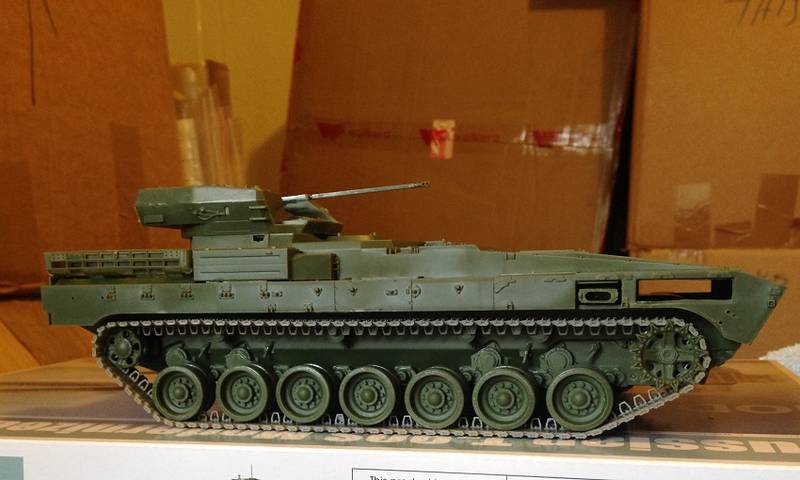The hull passive armour components add even more to the already bulky size of the T-15 Armata.
Designed to reduce the ability for those nasty shaped charge warheads to spray hot molten metal and shrapnel all over the crew and Infantry the add-on armour modules flank the entire hull sides and frontal arc.
The kit parts depicting the add-on armour components are well detailed from bolts to hinges to mounting brackets. Panda did a great job of including a good amount of detail while keeping the assembly process quite simple.
The side hull armour components are broken down into the right and left side armour. There are only four parts for each of the left and right side armour sections.
There is a main part that will run the length of the hull. Integrated into the part is the rubberized side skirt. What I like about the side skirt is that it includes small but well molded hinge and pin detail at each section that a molded in wave appearance is present giving it a more realistic look. Added to the rear of the main part is a support piece. This piece will aid in supporting and placing the third and fourth parts. The third part is a small section of add-on armour that sits along the upper rear side hull. Panda could have chosen to mold this part into the main part but did not. I suspect it was to add an additional level of detail as the fourth part is the rear mounting bracket for the third part. Remember the small support arms that I mentioned that are to be attached to the hull for the add-on armour? Well, the fourth part which is the rear mounting bracket is designed to take those three small support arms. Again, be careful when attaching the support arms as they are delicate and if they are not at the correct downward angle they might not attached properly to the mounting bracket.
Once the four parts are assembles locating pins in the main part line up with holes on the hull side. The support arms attach to the mounting bracket and the big slabs of add-on armour are attached to the hull sides.
Side hull armour details...I do like the retaining pin detail on the side skirt sections.






The sharply angled frontal armour is the next component to be assembled and attached to the hull.
The frontal armour consists of:
1. Upper glacis plate armour panel part
2. Lower front hull armour panel part
3. Side angle armour parts
4. Tow cable and related parts
5. Headlights and guards
6. Counter- IED devices (not confirmed)
The upper glacis plate armour panel requires only the headlights and guards to be added. I have previously addressed the inaccuracy of the headlights. Having now received the Voyager Model T-14 Armata MBT headlight set I do believe that this small and inexpensive headlight set is a good option for replacement headlights.
The lower hull part requires towing points and the tow cable with mounting brackets to be attached in order for it to be complete. It is a positive that Panda has provided the tow cable as braided metal cable instead of string. You have to be careful and not jump the gun and attach the tow cable ends right away. First you need to slip on the two mounting brackets. Don’t glue the brackets in place and let them slide freely along the cable. This will aid in the correct placement and attachment to the lower hull part mounting holes.
The point angled side armour parts have angle support frames that attach to the left and right parts prior to attachment to the components.
The upper and lower parts mate together and the side angled parts are added to provide a solid single beak like component that essentially slides on to the front of the hull and attaches to two slots in the glacis plate.
What I believe to be Counter-IED devices look like two large H shaped components. Two grab handles are added to each part and they are simply attached to the lower front hull. When looking at the parts it looks like these components can be removed or lowered from the lower front hull stowed position. They are hinged on the bottom and look like they have some type of articulating arms internally. They are held in place by a single rotating clamp. If they are ECM devices they may travel at or near ground level when deployed or lowered. The grab handles would assist in lowering the raising the components. If anyone has more information please do tell.
The final parts to be added to the hull sides are the downward angled add-on armour components providing protection to the engine exhaust areas. The left and right armour panels fit into locator points on the hull side and utilize three support rods to hold them in place. The instructions show the assembly process with the hull place upside down as this will probably greatly assist with the proper placement of the support arms. We will have to see if the lack of proper exhaust shroud makes a difference with these angled parts in place.
However, at least one image exists without the angled shroud...so what is accurate is in the eye of the beholder...or the builder in this case.

The hull assembly comprises of 15 steps of the 19 step instructions.
Upper front hull armour component with headlight mounts and integrated wiring.

Lower front hull add-on armour with mounting points for the front tow cable.

Angled side armour components.

H shaped Counter-IED device.

Add-on armour panel for exhaust area protection. Note that there is some visible flash on the small details.

The high tech remote turret is next so buckle up!
































































































